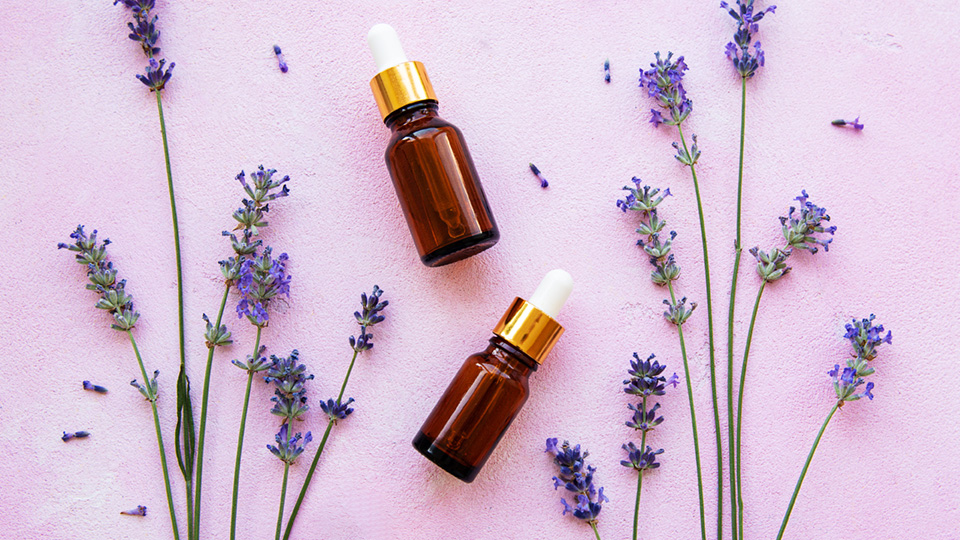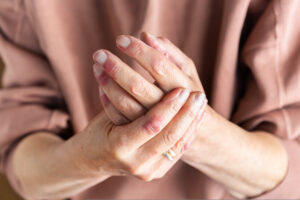Articles
By Melissa Tanoko
Published On: Oct 7, 2024
Last Updated On: Oct 7, 2024
Lavender has been a popular ingredient for thousands of years — the ancient Romans used it in their baths.1 But can it help heal eczema?
While scrolling for eczema treatments online, you may have come across claims that lavender can soothe a flare. There is some evidence that lavender may heal wounds,2 reduce inflammation3 and alleviate anxiety,4 which would all be useful for eczema.
However, dermatologists tell patients with eczema to avoid fragrances, including lavender. Is lavender an exception to the rule? Here, we will explore how the ingredient lavender impacts people with eczema.
What is lavender and how does it show up in products?
Lavender is a bushy plant with purple flowers and is a member of the mint family.1 It has long been used in perfumes, medicines, foods and beverages.1
When people recommend using lavender to treat skin conditions, they are usually referring to an essential oil distilled from the plant. This is done by boiling or steaming lavender, then collecting the resulting oil.5
Lavender essential oil can be purchased in many grocery and drug stores. It is also commonly used as an ingredient in lotions, soaps and even household cleaning products.
Two chemicals found in lavender called linalyl acetate and linalool are also widely used. They can both be found in perfumes, cleaning products, laundry detergents, soaps, deodorants, sunscreens and pet care items.6-7 Linalool is more widespread and can also be found in makeup, children’s finger paints, facial wipes, nail polish, lotion, toothpaste, chewing gum, soda, meat and baked goods.6,8
How does lavender affect people with eczema?
In short, lavender is not recommended for people with eczema. “The risk of allergic reactions and irritancy outweighs the purported calming and soothing effects [of lavender],” said Dr. JiaDe (Jeff) Yu, a board-certified dermatologist at Massachusetts General Hospital in Boston.
Lavender fragrance is known to trigger eczema flares. Dr. Yu explained that it and other fragrances should be avoided by people with any type of eczema including atopic dermatitis, contact dermatitis and dyshidrotic eczema.
According to Dr. Yu, lavender exposure could cause “itchy rash, redness, scaling — all the symptoms that you would expect in an eczema flare.”
How common are these reactions? One study of 2,178 people in an Australian clinic found that 2.2% of people patch tested with lavender showed a reaction to it.9 Most of the people in this study were exposed to lavender through an essential oil, perfume, skincare or washing product.9
Linalool can also be problematic. “Linalool when oxidized (comes in contact with air) becomes hydroperoxides of linalool, which is now reported to be one of the top 10 allergens in adults and children,” said Dr. Yu. “It’s a very common allergen I see in my clinic.” He noted that linalool can additionally be found in plants such as bergamot, rosewood and jasmine.
Research on oxidized linalyl acetate suggests it can also cause allergic reactions at a rate similar to lavender (2.8%).10
How do you spot lavender, linalyl acetate and linalool in products?
Since lavender and its chemical relatives can be found in so many products, it’s difficult to avoid them. But knowing what to look for can be a huge advantage.
If you have eczema, read the labels carefully on all your personal care, cosmetic and household items to weed out any with lavender, linalyl acetate and linalool. Since manufacturers are not required to list all the ingredients used in fragrances,11 it’s a good rule of thumb to avoid “fragrance” or “parfum” too.
If you have a diagnosed allergy to any of these ingredients, check in with your allergist to find out whether you should avoid them in foods as well.
If you’re looking for fragrance-free skincare or household products that have been reviewed by a panel of eczema experts, check out the National Eczema Association’s Seal of Acceptance™ Product Directory.
References:
- Lavender. Encyclopedia Britannica. Updated September 24, 2024. Accessed September 27, 2024. https://www.britannica.com/plant/lavender
- Samuelson R, Lobl M, Higgins S, Clarey D, Wysong A. The effects of lavender essential oil on wound healing: A review of the current evidence. J Altern Complement Med. 2020;26(8):680-690. https://pubmed.ncbi.nlm.nih.gov/32589447/
- Vakilian K, Atarha M, Bekhradi R, Chaman R. Healing advantages of lavender essential oil during episiotomy recovery: A clinical trial. Complement Ther Clin Pract. 2011;17(1):50-53. https://www.sciencedirect.com/science/article/abs/pii/S1744388110000381
- Donelli D, Antonelli M, Bellinazzi C, Gensini GF, Firenzuoli F. Effects of lavender on anxiety: A systematic review and meta-analysis. Phytomedicine. 2019;65:153099. https://pubmed.ncbi.nlm.nih.gov/31655395/
- Wainer J, Thomas A, Chimhau T, Harding KG. Extraction of essential oils from Lavandula × intermedia ‘Margaret Roberts’ using steam distillation, hydrodistillation, and cellulase-assisted hydrodistillation: Experimentation and cost analysis. Plants (Basel). 2022;11(24):3479. https://www.ncbi.nlm.nih.gov/pmc/articles/PMC9785002/
- National Center for Biotechnology Information. PubChem compound summary for CID 6549, linalool, (+/-)-. Accessed Sept. 27, 2024. https://pubchem.ncbi.nlm.nih.gov/compound/Linalool#section=Use-and-Manufacturing
- National Center for Biotechnology Information. PubChem compound summary for CID 8294, linalyl acetate. Accessed Sept. 27, 2024. https://pubchem.ncbi.nlm.nih.gov/compound/Linalyl-acetate#section=Use-and-Manufacturing
- National Institutes of Health. Nomination background: Linalool (CASRN: 78-70-6): Summary of data for chemical selection. Accessed Sept. 24, 2024. https://ntp.niehs.nih.gov/sites/default/files/ntp/htdocs/chem_background/exsumpdf/linalool_508.pdf
- Bingham LJ, Tam MM, Palmer AM, Cahill JL, Nixon RL. Contact allergy and allergic contact dermatitis caused by lavender: A retrospective study from an Australian clinic. Contact Dermatitis. 2019;81(1):37-42. https://pubmed.ncbi.nlm.nih.gov/30779160/
- Hagvall L, Christensson JB. Patch testing with main sensitizers does not detect all cases of contact allergy to oxidized lavender oil. Acta Derm Venereol. 2016;96(5):679-83. https://pubmed.ncbi.nlm.nih.gov/26671837/
- U.S. Food and Drug Administration. Fragrances in cosmetics. Updated February 28, 2022. Accessed September 27, 2024. https://www.fda.gov/cosmetics/cosmetic-ingredients/fragrances-cosmetics






